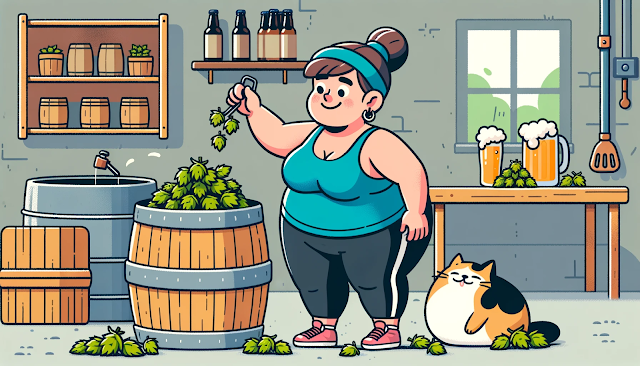Every brewer, novice or experienced, dreams of crafting a beer that not only tantalizes the taste buds but also feels delightful as it glides down one's parched throat.
A beer with a creamy mouthfeel can elevate the entire drinking experience, making it memorable.
Before diving into the techniques, it's crucial to understand what we mean by a "creamy" beer.
If you've ever savored a pint of Kilkenny or Guinness, you've experienced this creamy sensation. While their unique flavors are a topic for another day, their texture serves as an ideal benchmark for a beer with a perfect creamy consistency.
A significant aspect of this texture is the innovative combination of carbon dioxide and nitrogen these beers are infused with.

Incorporate More Malt:
Malt is a brewer’s secret weapon when it comes to achieving the ideal mouthfeel. It doesn’t just affect the flavor; malt has a significant impact on the body and texture of your beer.
By adding more malt, especially unfermentable sugars, you can enhance the beer’s viscosity, giving it a richer, fuller mouthfeel that’s often described as creamy or smooth. This approach is particularly useful when brewing styles like stouts, porters, and certain lagers, where a more substantial mouthfeel is desired.
There are several ways to increase the malt profile and achieve a thicker, creamier beer:
-
Increase the Mash Gravity: One of the most straightforward ways to add more malt character is by increasing the overall grain bill.
This can be done by adding more base malt or using specialty malts that contribute to the body. For example, Munich malt, Vienna malt, and Caramel/Crystal malts add not only sweetness but also increased body.
Increasing the mash gravity will result in a higher final alcohol content, but it also boosts the beer's viscosity, making it feel fuller and richer.
-
Use Specialty Malts for Mouthfeel: If you're looking for that smooth, velvety texture, consider adding flaked grains like flaked oats or flaked wheat.
These grains contain high levels of soluble fiber, which don’t ferment and help create a thicker, more silky mouthfeel. Flaked oats, in particular, are often used in brewing oatmeal stouts or hazy IPAs to impart a soft, creamy texture.
Additionally, using wheat malt or rye malt can enhance mouthfeel, giving the beer a rounder, fuller texture.
-
Incorporate Unfermentable Sugars: Malt isn't the only ingredient that contributes to a rich mouthfeel. Adding unfermentable sugars like lactose (milk sugar) is an effective way to boost the creamy texture of your beer without impacting the fermentation process.
Lactose isn’t fermentable by regular beer yeast, meaning it remains in the beer and adds a slight sweetness and body, making it an excellent addition to milk stouts or even milk IPAs.
Other unfermentable sugars like dextran or maltodextrin can also be used to increase body without affecting sweetness, offering a subtle thickness to the beer.
-
Adjust Mash Temperature: Your mash temperature plays a critical role in the final mouthfeel of the beer. Mashing at a higher temperature, typically around 156-158°F (69-70°C), encourages the production of higher molecular weight sugars, which are less fermentable.
These sugars contribute to the beer’s body and mouthfeel, giving it a fuller texture. The resulting beer will be less dry and have a more viscous, smooth feel, ideal for richer styles.
-
Experiment with Higher-Protein Malts: Certain malts have higher protein content, which contributes to the body of the beer by increasing the beer’s viscosity and creating a smoother, thicker mouthfeel.
Wheat malt, barley malt, and spelt are examples of high-protein malts that can enhance mouthfeel, especially when used in combination with other malts. Additionally, malts that undergo a more intense kilning process, like roasted barley or chocolate malt, can add both color and body to darker beers.
-
Consider Using a Mash Additive: To further enhance the texture of your beer, you might consider using adjuncts such as guar gum or xanthan gum, both of which are commonly used in brewing to create a smoother, more viscous mouthfeel.
These should be used sparingly, as they can have a noticeable impact on texture, and overuse can result in an overly thick beer. They’re particularly useful in certain experimental or gluten-free brews where you might need to mimic the body typically provided by malted barley.
-
Try the "Reverse" Cold Crashing Method: While cold crashing is usually about clearing the beer, a technique known as reverse cold crashing can be used to enhance mouthfeel.
When beer is cold crashed too quickly or to too low a temperature, some of the proteins that would otherwise contribute to mouthfeel can precipitate out. By allowing the beer to cool slowly or at a slightly higher temperature, you can keep more of these proteins in suspension, which can help boost the overall texture of the beer.
-
Blending: If you’re brewing multiple batches, you could consider blending different beers with varying levels of body.
For example, you might have a more straightforward, lighter beer and one that has a higher malt load. Blending these beers allows you to control the body and mouthfeel without committing entirely to one recipe.
This is especially useful if you’re brewing for a specific crowd or style but want to tweak the mouthfeel to fit a desired profile.
Experiment with Lactose:
Lactose, a type of sugar derived from milk, is a powerful tool when it comes to enhancing mouthfeel. What sets lactose apart from other sugars is its unique inability to ferment when introduced to yeast.
This non-fermentable property means that it doesn’t get converted into alcohol or carbon dioxide, and instead, it remains in the beer, providing extra sweetness and increasing the beer's body. The result is a smoother, creamier mouthfeel, which is why lactose is a key ingredient in Milk Stouts and Milk IPAs.
The richness it imparts can make a beer feel fuller and more indulgent, with a distinct "milky" or "creamy" texture that sets these beers apart.
To experiment with lactose, you can start by adding small amounts (typically around 4-8 ounces per gallon) to your brew during the boil or at the end of fermentation. This allows the lactose to dissolve properly and blend seamlessly into the beer.
However, don’t expect lactose to be a one-size-fits-all solution—its sweetness can potentially alter the flavor profile of lighter beers, so it’s best suited for styles where a richer, creamier mouthfeel is desired, such as stouts, porters, or even pastry stouts and dessert-style beers.
If you're brewing a beer like a hazy IPA or pale ale, consider using lactose sparingly, as its sweetness might clash with the hop-forward characteristics of these styles.
Some brewers may also use pre-mixed beer enhancers that contain lactose, along with other adjuncts, which can give your brew that creamy edge without needing to buy lactose separately. These pre-mixed options are convenient and designed to work well with specific beer styles, making it easy to get that perfect creamy texture without a lot of trial and error.
When experimenting with lactose, be mindful of the level of sweetness it adds; too much can make the beer overly sweet and unbalanced. The key is moderation, as you’re looking to enhance the mouthfeel without overpowering the flavor.
Employ High Alpha Hops:
While hops are primarily known for adding bitterness to beer, they serve a more nuanced purpose beyond just balancing malt sweetness. High alpha hops, in particular, have a significant role in both the bitterness and head retention of a beer.
These hops, which have higher concentrations of alpha acids, contribute to the isohumulone levels in beer. Isohumulones are a key component that helps maintain the beer’s foam stability, giving it a more robust and long-lasting head.
This can be especially important in beers that are meant to have a creamy or frothy mouthfeel, as a stable, persistent head can greatly enhance the overall sensory experience.
When using high alpha hops, it’s crucial to strike a balance. These hops not only increase bitterness but also impact the beer’s aroma and flavor.
For example, Chinook, Columbus, or Simcoe are known for their higher alpha acid content and are great options for beers like IPAs or Imperial Stouts, where bitterness is needed to balance the sweetness from the malt or other adjuncts.
But don’t overdo it—too much bitterness can overwhelm the beer and detract from the smoothness you’re aiming for with other ingredients like lactose.
In addition to boosting bitterness and enhancing head retention, high alpha hops can contribute to the overall mouthfeel by providing a firm backbone that supports the beer’s texture. This is particularly important when you’re brewing beers with higher alcohol content or those that might otherwise feel too light or thin.
A strong hop presence can also elevate the creamy sensation by balancing out any residual sweetness from adjuncts like lactose or caramel malts.
To achieve the perfect head retention with high alpha hops, consider adding them in the late stages of the boil, or during dry hopping. This allows the alpha acids to interact with the beer more subtly without introducing too much bitterness.
You can also experiment with combining high alpha hops with other hop varieties that have lower alpha acids but higher aromatic oils, which can contribute to a complex hop profile and add another layer of depth to your beer.

The Guinness Approach - Nitrogen and CO2:
If you're looking to replicate the exact creaminess of a Guinness, consider infusing your beer with a mix of nitrogen and CO2. While this method requires investment in specialized equipment, the results can be truly remarkable.
While the pursuit of the perfect creamy beer is commendable, it's essential to remember some boundaries. For instance, while cream might seem like an obvious choice for achieving creaminess, adding it to your fermenter is ill-advised.
Not only can it offset the beer's flavors, but it can also significantly increase the chances of beer contamination.
So, as you embark on your brewing journey, remember that with a little experimentation and the right techniques, achieving that dreamy creamy mouthfeel is within your grasp.
Cheers to that!















